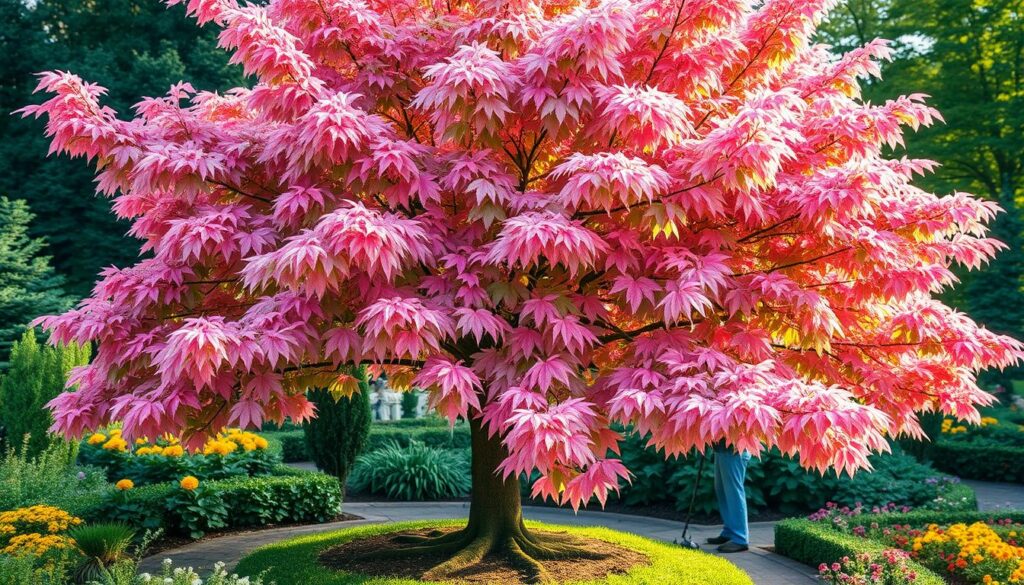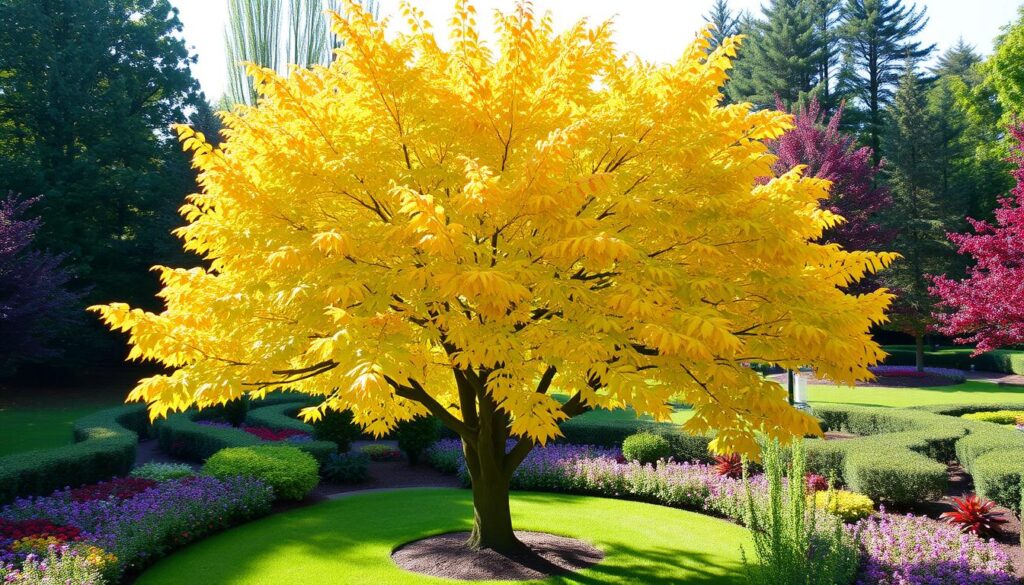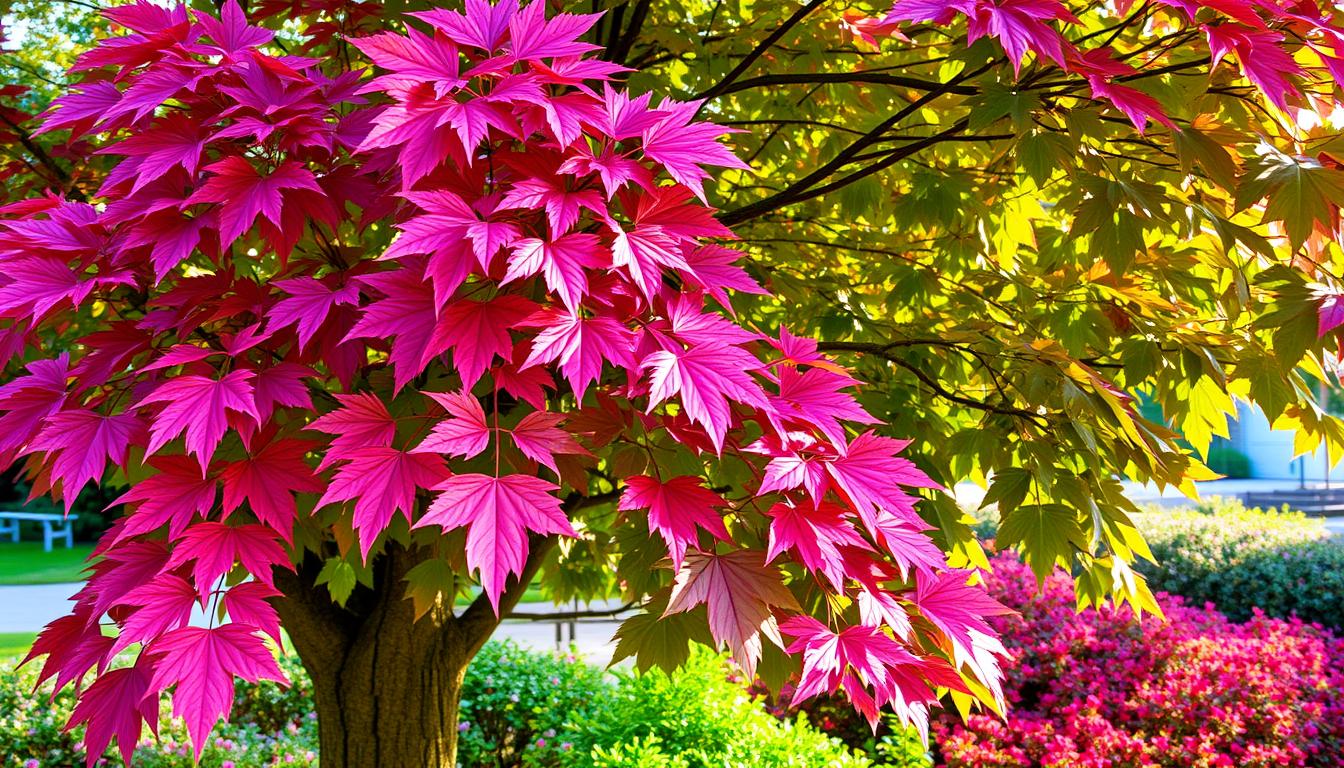As you step into your backyard, a breathtaking vision unfolds before your eyes. A majestic tri color beech tree stands out, its leaves shimmering with a mesmerizing blend of green, purple, and bronze. This captivating ornamental plant is truly a sight to behold, commanding attention and drawing admiring gazes from all who witness its splendor.
Whether you are a seasoned gardener or a nature enthusiast, the tri color beech tree is a must-have addition to any landscape. It serves as a stunning focal point that will leave a lasting impression on all who experience it.
Table of Contents
Understanding the Tri Color Beech Tree’s Origins
The tri color beech tree is known for its stunning leaves. It has a long history that goes back centuries. It comes from the Fagaceae family of deciduous trees and shrubs.
Native Habitat and Historical Background
The tri color beech tree comes from the European beech (Fagus sylvatica). This tree is native to central and western Europe. It grows well in temperate forests, often with oak, maple, and other hardwoods.
The European beech is famous for its size, strong growth, and beautiful fall colors.
Development of the Tricolor Cultivar
The tri color beech tree’s unique leaves come from a natural mutation in the European beech. Horticulturists saw these special trees and chose to breed them. They worked to keep the tricolor leaves, creating the tree we love today.
Scientific Classification and Family Relations
The tri color beech tree is part of the Fagaceae family. This family includes oak, chestnut, and the European beech. The tri color beech is a special version of Fagus sylvatica, sharing many traits with its parent.
“The tri color beech tree is a true work of nature’s artistry, a captivating blend of colors that brings a touch of magic to any landscape.”
Distinctive Features and Characteristics
The tri color beech tree stands out among ornamental plants. Its colorful foliage and tall stature make it a favorite specimen tree. Let’s explore what makes this tree so special.
The tree’s leaves are a mix of green, purple, and bronze. In spring, they show off a beautiful color display. The young leaves are deep purple, changing to green and bronze as the season goes on.
The tree’s shape is elegant and pyramidal, adding beauty to any garden. Its smooth, silvery-gray bark is interesting all year, even when the leaves are gone.
“The tri color beech tree is a true masterpiece of nature, a living work of art that captivates the senses with its ever-changing, breathtaking display of color.”
As a focal point or part of a landscape design, the tri color beech tree impresses. Its unique features and beauty are unforgettable.
The Magic of Tri Color Beech Tree Foliage
The tri color beech tree is a true marvel, captivating all who see it. Its foliage changes colors throughout the season. From vibrant spring colors to stunning summer patterns and brilliant fall colors, it’s a standout in any garden.
Spring Color Display
When spring arrives, the tri color beech tree wakes up, showing off its amazing foliage. The leaves start as a mix of burgundy, green, and bronze, creating a beautiful pattern. This colorful start adds seasonal interest and prepares for the tree’s future changes.
Summer Leaf Patterns
In summer, the tree’s leaves grow, showing off their unique patterns. They turn a mix of dark burgundy, light green, and bronze, making a stunning sight. This colorful foliage makes the tri color beech a key feature in any landscaping trees design.
Fall Color Transformation
The fall is when the tri color beech tree really shines. Its leaves change to rich burgundy, vibrant orange, and brilliant gold. This autumn display is a sight to behold, making the tri color beech a top choice for adding seasonal interest and colorful foliage to your landscaping trees.
“The tri color beech tree is a true masterpiece of nature, captivating the senses with its ever-changing, breathtakingly beautiful foliage.”
Ideal Growing Conditions and Requirements
To thrive, the stunning tri color beech tree needs specific growing conditions. It loves shade, especially partial sun to shaded spots. It also needs protection from strong sunlight during the day.
The tri color beech grows best in well-drained, slightly acidic soil. It prefers a pH between 5.5 and 6.5. This helps it stay healthy and vibrant.
This unique tree does well in USDA hardiness zones 4 to 7. It can handle cooler climates. Make sure to water it regularly, especially in the first two years. This helps it develop a strong root system.
- Prefers partial sun to shade, avoiding direct, harsh sunlight
- Thrives in well-drained, slightly acidic soil (pH 5.5-6.5)
- Performs best in USDA hardiness zones 4-7, where it can tolerate cooler temperatures
- Requires consistent watering, especially in the first two years after planting
By giving the tri color beech the right growing conditions, it will reach its full beauty. You’ll enjoy its stunning foliage and vibrant colors all year round.
Planting Your Tri Color Beech Tree
Planting a landscaping tree like the stunning Tri Color Beech can be rewarding. It adds beautiful ornamental plants to your outdoor space. To ensure success, following proper planting techniques is key. Let’s look at the important steps to start your Tri Color Beech tree right.
Site Selection Guidelines
When picking the perfect spot for your Tri Color Beech, think about sunlight, space, and distance to other plants. These trees need well-drained soil and partial shade. So, choose a spot that fits these needs for their health and growth.
Soil Preparation Methods
- Test your soil’s pH and adjust it to the best range of 5.5 to 6.5.
- Add organic matter like compost or well-rotted manure to enrich the soil.
- Loosen the soil to 12-18 inches deep for easy root growth.
Planting Time and Techniques
The best time to plant a Tri Color Beech is in spring or fall when it’s dormant. This reduces transplant shock and helps roots grow well. When planting, make sure the root ball is level with the soil. Backfill with the original soil, then water well and mulch around the base, avoiding the trunk.
“Proper planting of a Tri Color Beech tree is the foundation for its long-term success and vibrant foliage display.”
By using these planting techniques, your Tri Color Beech will thrive. It will become a beautiful centerpiece in your landscaping.
Essential Care and Maintenance Tips
Keeping a tri color beech tree healthy is all about balance. It’s about low-maintenance trees, tree care, and landscaping trees. With the right steps, your tree will thrive for many years.
Watering is key for your tree’s health. Water it deeply once a week for the first year after planting. As it grows, water it every two to three weeks during dry times.
Fertilizing is also vital. Use a slow-release, balanced fertilizer in early spring. Follow the instructions carefully. Don’t overdo it, as too much can harm the tree.
Pruning is crucial for the tree’s shape and health. Prune in late winter or early spring. Remove dead, damaged, or crossing branches. You can also shape the tree as you like.
Mulching helps keep the soil moist and weeds away. Use 2-3 inches of organic mulch, like wood chips, but keep it away from the trunk.
By following these low-maintenance trees care tips, your tri color beech tree will be a stunning centerpiece. It will be a highlight of your landscaping trees design for years.

Common Problems and Solutions
The tri color beech is a beautiful ornamental tree that needs careful tree care. It has vibrant foliage and stays healthy with the right care. These trees are mostly tough, but they can face some common issues.
Disease Prevention
Tri color beeches are at risk for disease. They can get leaf scorch, canker diseases, and fungal infections. To stop these problems, it’s key to take steps to prevent disease. This includes:
- Watching the tree for early signs of disease and fixing problems fast
- Keeping the soil well-drained and the right moisture to stop fungus
- Pruning bad or damaged branches to stop disease spread
- Using fungicides if needed to prevent disease
Pest Management
Tri color beeches also face pest issues like aphids, scale insects, or borers. Good pest management can keep pests away and protect the tree. Important steps include:
- Checking the tree often for pests
- Encouraging good insects that eat pests
- Using safe, eco-friendly insecticides if needed
- Removing badly infested or damaged branches to stop pest spread
Environmental Stress Factors
Tri color beeches can also be affected by environmental stress like drought, extreme weather, or soil compaction. To help the tree do well, it’s important to:
- Give it enough water, especially when it’s dry
- Protect it from too much sun and wind
- Make sure the soil is well-aerated and not compacted
- Watch the tree’s health and fix any environmental stress quickly
By tackling common tree care issues, gardeners can help their tri color beech trees thrive. They will keep looking great in the landscape for many years.
Landscape Design Applications
The tri color beech tree is a stunning addition to any landscape. Its vibrant foliage and elegant form make it a standout. It can be a focal point or add interest all year as a specimen tree.
Tri color beeches can play many roles in a landscape. They draw the eye with their colors and patterns. They can also act as natural screens, adding depth and texture.
Pairing tri color beeches with other plants creates a cohesive look. Their unique leaves highlight the colors and shapes of nearby plants. They enhance both formal and naturalistic gardens, making your space more beautiful.
“The tri color beech tree’s captivating display of color and form makes it a versatile and invaluable addition to any landscape design.”
Think about where to place your tri color beech for the best effect. Try it in modern or naturalistic gardens. See how it changes your outdoor space.
Seasonal Changes and Year-Round Interest
The tri color beech tree is a true visual delight. It offers captivating seasonal changes that keep your garden vibrant and engaging year-round. From its striking winter architectural appeal to the colorful foliage displays of spring, summer, and fall, this remarkable deciduous tree is a showcase of seasonal interest.
Winter Architectural Appeal
When the leaves have fallen, the tri color beech tree’s unique branching structure and elegant silhouette come into sharp focus. The interplay of light and shadow on its smooth, silvery-gray bark creates a mesmerizing visual effect. This adds drama and sophistication to the winter landscape.
Spring Growth Patterns
As the weather warms, the tri color beech tree bursts into life with a stunning display of new growth. Delicate, copper-toned leaves unfurl, gradually transforming into a tapestry of deciduous trees in shades of green, pink, and purple. This captivating spring show sets the stage for the summer and fall seasons to come.
Summer and Fall Highlights
During the summer months, the tri color beech tree’s foliage takes center stage, showcasing a breathtaking array of colorful foliage patterns. As autumn approaches, the leaves transition to brilliant hues of gold, orange, and red. This creates a stunning seasonal display that leaves a lasting impression.
Whether it’s the winter silhouette, spring bud break, summer foliage, or fall color transformation, the tri color beech tree is a true four-season masterpiece. It offers a captivating seasonal interest that will enchant your garden year after year.

Companion Plants and Garden Pairings
The tri color beech tree is a stunning centerpiece for any garden. To make it even more breathtaking, pairing it with the right trees and shrubs is key. Let’s look at some beautiful plants that will make your garden stand out.
Pairing the tri color beech with a Japanese maple is a great choice. The maple’s delicate leaves contrast beautifully with the beech’s bold colors. This combination creates a stunning visual effect that will amaze everyone.
- Planting azaleas or rhododendrons with the tri color beech adds vibrant colors. Their bold flowers complement the tree’s foliage, making a striking display.
- Ornamental grasses add texture and depth when paired with the tri color beech. The grasses’ flowing movements highlight the tree’s strong presence, creating a dynamic look.
- Hydrangeas and the tri color beech make a sophisticated pair. The hydrangeas’ soft flowers contrast with the tree’s unique leaves, creating a harmonious and elegant scene.
To make your garden with a tri color beech tree truly stunning, think about the colors, textures, and growth habits of your plants. By choosing the right companions, you’ll highlight the tree’s beauty and turn your garden into a masterpiece.
“The tri color beech tree is a stunning focal point, but it truly shines when paired with the right companion plants.”
Growth Rate and Size Expectations
When it comes to the tri color beech tree, gardeners and landscapers need to consider its growth rate and mature size. These shade trees, specimen trees, and landscaping trees are known for their impressive stature and longevity. They make a valuable addition to any property.
The tri color beech is a fast-growing tree, adding up to 2 feet of height per year. With proper care and growing conditions, it can reach its full size in 15-20 years. However, its growth rate will slow down as it matures. It will then reach a height of 40-60 feet and a spread of 30-50 feet.
- Tri color beech trees have a long lifespan, often living for 100-150 years or more with proper care.
- As the tree ages, it develops a majestic, rounded canopy. This provides ample shade trees for your outdoor living spaces.
- The tri color beech’s impressive size makes it a stunning specimen tree. It can serve as a focal point in your landscape design.
“The tri color beech is a true showstopper, with its stunning foliage and impressive stature. Homeowners and landscapers alike will appreciate the tree’s long-term benefits and year-round visual interest.”
When planning your landscape, make sure to allocate enough space for the tri color beech. With its sizeable spread and height, these landscaping trees need ample room to thrive and showcase their beauty.
Conclusion
The tri color beech tree is a standout ornamental plant. It can be a beautiful centerpiece for your garden. Its changing foliage brings joy all year long.
Looking to add elegance or a focal point to your garden? A tri color beech tree is a great choice. Its unique colors and shape make it a highlight in any garden.
Think about adding a tri color beech tree to your garden. It will bring lasting beauty and joy. With the right care, it will be a highlight of your landscape for years.

